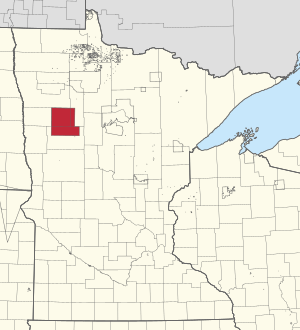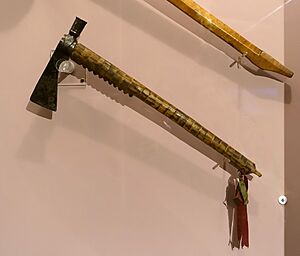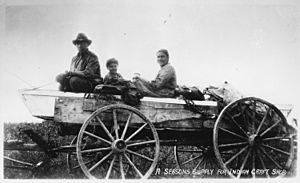White Earth Indian Reservation facts for kids
The White Earth Indian Reservation is a special area of land in northwestern Minnesota. It is the home of the White Earth Band of Ojibwe, also known as the Anishinaabe people. In their language, Ojibwe, the reservation is called Gaa-waabaabiganikaag, which means "Where there is an abundance of white clay."
This reservation is the largest in Minnesota by land size. It covers all of Mahnomen County and parts of Becker and Clearwater counties. The Wild Rice and White Earth rivers flow through it. The reservation's land area is about 1,093 square miles (2,831 square kilometers). In 2020, about 9,726 people lived there.
The White Earth Indian Reservation is one of six groups that form the Minnesota Chippewa Tribe. This tribe helps manage important things for its members. The reservation is about 225 miles (362 km) from Minneapolis–Saint Paul. It is also about 65 miles (105 km) from Fargo–Moorhead.
The White Earth Reservation was created on March 19, 1867. This happened through a special agreement called a treaty. Ten Ojibwe chiefs met with President Andrew Johnson in Washington, D.C., to make this treaty. Some of the first leaders to move their people to White Earth in 1868 were Wabanquot (White Cloud) and Fine Day.
The reservation was originally much larger, covering about 1,300 square miles (3,367 square kilometers). Over time, some of this land was unfairly sold or taken by others. This included land taken by the U.S. federal government. This happened in the late 1800s and early 1900s.
Later, in the second half of the 1900s, the government worked to give some state and county land back to the reservation. This was to make up for the land that had been lost. In 1989, a group called the White Earth Land Recovery Project was started by Winona LaDuke. This group works to buy back privately owned land to return it to the reservation. At that time, less than 10% of the land within the reservation's borders was owned by tribal members.
The White Earth Band government runs the Shooting Star Casino, Hotel, and Event Center in Mahnomen, Minnesota. This large entertainment complex provides jobs for over 1,000 people. Many of these workers are tribal members, but some are not. There is also a new location in Bagley, Minnesota. The White Earth community is known for its tradition of singing special songs called hymns in the Ojibwe language.
Contents
History of the White Earth Reservation
Before the White Earth Reservation was officially created, Ojibwe people already lived in the area that is now Mahnomen County.
Ojibwe Soldiers in the Civil War
During the United States Civil War, a group of soldiers from G Company of the 9th Minnesota Infantry Regiment included many people who were part Ojibwe. They served in the war because some white citizens in Crow Wing paid them to take their place. This was allowed by a law at the time.
These soldiers were sent to Fort Abercrombie in Dakota Territory. When they arrived on September 3, 1863, the fort was being attacked by Sioux warriors. The Ojibwe soldiers helped fight off the attack. They then stayed at the fort during a long siege.
Later, G Company was sent south to fight in other battles. They were known for being very good at skirmishing, which means fighting in small, spread-out groups. They helped protect other soldiers during a difficult retreat. They also fought in battles like the Battle of Tupelo and the Battle of Nashville. They returned to St. Paul, Minnesota in August 1865, having lost few soldiers.
How the Reservation Was Established
At first, the United States government wanted to move all Anishinaabe people from Michigan, Wisconsin, and Minnesota to the White Earth Reservation. Their plan was to then open up the lands these people left behind for European Americans to settle. The U.S. government even thought about moving the Dakota people to White Earth, even though the Ojibwe and Dakota had been traditional enemies. The U.S. government continued this idea until 1898.
On July 8, 1889, the United States changed its mind. It told the Minnesota Chippewa that the Red Lake and White Earth Reservations would stay. However, other reservations would be closed, and their people would be moved to White Earth. Instead of talking to the Chippewa tribes as separate nations, the government decided to let individual tribal members vote on how their shared land would be used.
They said that adult Chippewa men could vote on whether to accept land allotments. Allotments meant that each family would get a small piece of land for farming. Any land left over after these allotments would be called "surplus" and could be sold to non-Native American settlers. Chippewa leaders were very upset by this. They knew that their people usually followed the decisions made by their tribal councils. Also, many Dakota men, who were not part of the Chippewa tribe, were allowed to vote.
The Chippewa leaders did not trust how the vote was managed. For example, white people who wanted to buy the "surplus" land were the ones counting the votes, not the Chippewa. Leaders from the Red Lake Reservation warned the government about problems if their land was taken. The White Earth and Mille Lacs reservations supposedly voted to accept the land allotments and allow surplus land to be sold. The Leech Lake Reservation also supposedly voted to accept allotments. However, events like the Battle of Sugar Point in October 1898 suggested otherwise.
In 1889, the White Earth Reservation was about 1,093 square miles (2,831 km²) in size. After the votes were counted, the government claimed that the vote strongly supported selling the "surplus" lands to settlers. This left only a small part of the original White Earth Reservation. Most other Minnesota Chippewa reservations were closed. However, a rebellion on the Leech Lake Reservation in 1898 helped save Minnesota's Chippewa reservations, including White Earth and Red Lake.
Before the Nelson Act of 1889 took effect, groups of Anishinaabe and Dakota people started moving to the White Earth Reservation from other reservations. Records from the 1920 census show where the Anishinaabe living on White Earth originally came from. There were 4,856 from the Mississippi Band of Chippewa (including over 1,000 from the Mille Lacs band and many Dakota). The Pillagers numbered 1,218, the Pembina Band were 472, and 113 were from Fond du Lac and other Lake Superior Chippewa bands.
Leadership on the Reservation
In 1885, Joseph, the youngest son of Chief Hole in the Day II, was supported by former governor Alexander Ramsey. Joseph was considered for a special military school called West Point. He traveled to Washington D.C. to meet President Cleveland, which was big news. Everyone thought he was a good choice. A year later, Joseph left his job with the U.S. Postal Service to become a Chief on the White Earth Reservation. He later joined the military to fight in the Spanish American War.
Joseph and his older brother, Ignatius Hole-in-the-Day, were both well-educated and became chiefs on White Earth. Ignatius went to an Indian school and later graduated from St. John's College. Joseph studied at the Haskill Institute and the University of Minnesota. Ignatius gave talks about Ojibwe history across the state. Joseph worked for the Bureau of American Ethnology, writing down traditional stories and knowledge.
Communities on the Reservation
The White Earth Reservation has many towns and settlements within its borders. Some of these places have mostly non-Native residents, or a mix of Native and non-Native people. Today, whether someone is considered Ojibwe often depends on how they live their culture. Some community members prefer to call themselves Anishinaabe or Ojibwe. Others prefer the name "Chippewa." The word "Chippewa" is the English version of Ojibwe, used by early European settlers in the U.S. The French in Canada used "Ojibwa."
Traditionally, the Ojibwe had a patrilineal society. This means that children belonged to their father's family group (clan) and inherited their social standing from his side of the family.
Towns that are mostly Native American include Elbow Lake, Naytahwaush (the largest Native community on the Reservation), Pine Point, Rice Lake, Twin Lakes, and White Earth (the second-largest Native settlement). Other communities like Waubun, Ogema, and Callaway are also considered to have mostly Native populations when people of mixed heritage are included. The largest town is Mahnomen, which has mostly non-Native residents.
Smaller settlements that are likely mostly Native American include Mahkonce, Maple Grove Township, Pine Bend, Roy Lake, and the Strawberry Lake region. In July 2007, the Minnesota Chippewa Tribe reported that 19,291 people were officially enrolled members of the White Earth Reservation. Most members live outside the reservation, especially those with Dakota ancestors. Many live in the Twin cities (Minneapolis-St. Paul) because there are more job opportunities there.
- Beaulieu
- Bejou
- Callaway
- Elbow Lake
- Mahnomen
- Midway
- Naytahwaush
- Ogema
- Pine Bend
- Pine Point
- Rice Lake
- Roy Lake
- South End
- The Ranch
- Twin Lakes
- Waubun
- West Roy Lake
- White Earth
People Living on the Reservation
According to the 2020 census, the total number of people living on the White Earth Reservation and nearby trust lands was 9,726. The reservation has a lot of non-Native people living there. This is because laws like the Nelson Act of 1889 allowed tribal lands to be sold to white settlers.
In 2020, the people living on the reservation were: 44.7% Native American, 43.2% White, 0.1% Asian, 0.1% Black or African American, 0.5% from other races, and 11.5% from two or more races. About 2.1% of the population was Hispanic or Latino.
The leader of the White Earth Reservation believes that the actual number of Native people living on reservations is higher than what the census counts. She explained that many families share homes, and sometimes these extra families are not counted. This might be because they are worried about being evicted if they participate in the census. It is possible that the number of White Earth Band members living on the reservation is actually larger than the number of white residents.
Economy and Jobs
The White Earth Reservation has an economy similar to other Native American reservations. In 2011, the White Earth Reservation government was a major employer, with nearly 1,750 staff members. The total amount paid in salaries was around $21 million. The reservation government hires both Native and non-Native people for its jobs. The Band also makes its own special license plates for vehicles.
The White Earth Reservation owns and runs several businesses. These include an Event Center, a hotel, the Shooting Star Casino, the White Earth Housing Authority, and the Reservations College.
The poverty rate on the White Earth Reservation can be almost 50%. The unemployment rate is nearly 25%. The White Earth Reservation is sometimes called the poorest reservation in Minnesota.
Land and Nature
The White Earth Reservation is located where the open prairie meets the boreal forest. About half of the reservation is covered by forests and lakes. Most of the trees are second-growth, meaning they grew back after the original, very old forests were cut down. In the late 1800s, logging companies cut down most of the old trees on the reservation.
The western part of the reservation has rich prairie land, where many farms are located. There are also many farms in the far northeastern part of the reservation.
The thickest forests are found between Callaway and Pine Point, stretching up to just west and north of Mahkonce. North of this area, the forest becomes less dense, especially around the Pine Bend and Rice Lake regions. There are some farms between Mahkonce and Pine Bend.
Many lakes are scattered across the reservation. Some of the large lakes include Bass Lake, Big Rat Lake, Lower Rice Lake, Many Point Lake, North Twin Lake-South Twin Lake, Roy Lake, Round Lake, Snider Lake, Strawberry Lake, Tulaby Lake, and White Earth Lake. The White Earth Land Recovery Project works to help tribal members own land on the reservation. They also support projects to replant trees and bring back the wild rice industry in the reservation's lakes. They even sell their own brand of wild rice and other products.
The 160,000-acre White Earth State Forest is part of the reservation. The land is still recovering from the damage caused by logging companies over a century ago. The reservation is very beautiful, especially during the spring, summer, and fall months.
Climate and Weather
The weather on the White Earth Reservation can be quite challenging. Winter lasts for at least three months. During these months, the average daily low temperatures are around 1°F (-17°C), -6°F (-21°C), and 0°F (-18°C). The table below shows average high and low temperatures for both winter and summer months.
| Month | December | January | February | June | July | August |
|---|---|---|---|---|---|---|
| Average low | 1°F (-17°C) | -6°F (-21°C) | 0°F (-18°C) | 52°F (11°C) | 56°F (13°C) | 54°F (12°C) |
| Average high | 20°F (-7°C) | 14°F (-10°C) | 21°F (-6°C) | 76°F (24°C) | 81°F (27°C) | 80°F (27°C) |
The average yearly precipitation (rain and snow) in Mahnomen is over 22 inches (56 cm).







